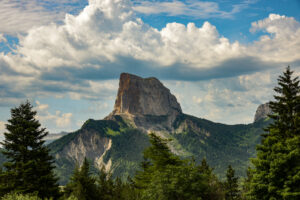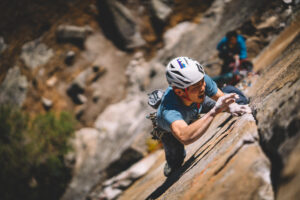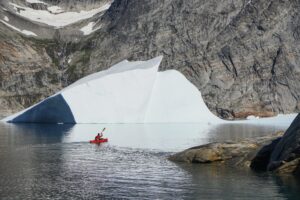James Pearson’s Le Voyage (E10, 7a) sat without a second ascent for five years after the Brit tamed it in 2017. Even the deluge of local climbing that COVID-19 engendered didn’t result in any repeats.
Simply put, that could be because it’s very hard and the only way to protect it is with small gear.
The route coheres around an 8b+/5.14a crux, which is safe but only marginally so. The vast majority of the seams that the monster 45m line follows are tiny, and they repeatedly close off. A long blank section with distinct but small, rounded pockets offers poor gear placements at best.
The resulting experience, fourth ascensionist Babsi Zangerl said, is “spicy.”
Zangerl and her partner, Jacopo Larcher, traveled to Annot, France in March with Le Voyage in mind. Along with Belgian crusher Siebe Vanhee, the trio claimed the route’s second, third, and fourth ascents.
Soon after, French climber Symon Welfringer hopped on the send train to snag the fifth ascent (the first by a climber from the route’s home country).
‘Spicy’: Zangerl on ‘Le Voyage’
“You protect it [on] your own with mobile gear,” Zangerl explained in a thorough Black Diamond video chronicling her group’s visit. “This makes it really spicy. For me, it was definitely scary to climb it.”
If by “mobile” she means “small,” her assessment of the Le Voyage rack is correct. The send footage is cut together between at least two different presumably successful attempts, but the biggest thing she’s carrying by far is a number 2 Camalot (hand-size). It’s also unclear whether she ever finds anywhere to place it.
Zangerl styles the route with grace and poise, levering her way up a complicated matrix of tiny footholds. Clearly, the line inspires her — to which she speaks at length in the video.
Trad climbers remain calm with ‘headpointing’
Larcher topped out the route first, and Vanhee and Zangerl then took turns practicing on it with a top rope. In Zangerl’s send footage, she appears to channel the focused energy that leading a challenging, serious route demands. Rehearsing a dangerous route on top rope to prepare for an eventual lead is called “headpointing.”
All three climbers on the trip have a lot of experience with the technique. Vanhee fleshed out the benefits.
“From the first lead try, I could really feel the real focus I was searching for. And I couldn’t get it [on top rope] — I was too distracted about details and the moves. ‘It needs to be perfect; it needs to be better.’ But then when you lead, you get into this really focused mindset — the zone we all climb for.”
Zangerl, visibly tired, bore down on the holds just below the anchor for a nail-biter of a send.
Welfringer also leveraged a headpoint to climb Le Voyage. The multi-talented Piolet d’Or winner has also climbed sport routes up to 8c+/5.14c.






